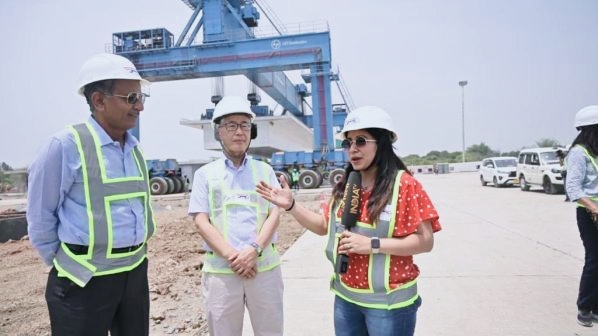Focus moves to Gujarat section of Mumbai-Ahmedabad high-speed line
Trial runs are due to begin on the 47 km Surat-Bilimora section in 2026
NHSRCL managing director, Mr Satish Agnihotri, and Japanese ambassador to India, Mr Satoshi Suzuki, speak to the media at a construction site in Surat, Gujarat
Srinand Jha
COMPLETION targets for the Mumbai – Ahmedabad high-speed line have been revised in line with plans to begin operation on the 352 km section in Gujarat state in 2027.
Trial runs will be conducted on a 47 km stretch connecting Surat to Bilimora in 2026, National High Speed Rail Corporation (NHSRCL) managing director, Mr Satish Agnihotri, has told.
India’s 508km high-speed corridor project has been subject to time and cost overruns due to multiple factors including Maharashtra state’s unwillingness to either allocate the Rs 50bn ($US 564m) in funding it is due to provide for the project, or to facilitate land acquisition to build a high-speed station at the Bandra – Kurla complex in Mumbai.
Unofficial estimates are that total project costs have climbed from Rs 1.08 trillion to Rs 1.8 trillion.
NHSRCL, the executing agency for the project, has also been struggling to acquire land in the Thane Creek area of Maharashtra where a 21 km tunnel, which includes a 7 km under sea section, is proposed.
While 99% of land required for the project has been obtained in Gujarat and the Union Territory of Dadra Nagar Haveli, only 68% has been acquired in Maharashtra.
In expectation that the Bandra-Kurla land would be made available, the NHSRCL issued tenders for civil works in 2019, but these bids were cancelled this year after being delayed 11 times. Last year, the corporation also tendered tunnel work near Thane Creek but this was also cancelled in February following several delays.
Following instructions from the prime minister’s office, NHSRCL has in recent months fast tracked work in Gujarat and the Union Territory of Dadar, Nagar, Haveli (DNB). There has been swift progress with earth works at several locations including Vapi, Surat, Boisar and Bharuch, with piers, girders and viaduct construction and well foundations in progress across 125 km of the line.
Contracts for track works on 237 km of the line in Gujarat have been awarded & tenders for the remaining 115 km will be awarded within a few months, NHSRCL officials say. Works on all eight high-speed rail stations in Gujarat are at various stages of construction.
The high-speed station at Surat – known as India’s diamond capital – is due to be completed next year, while the passenger terminal hub at Sabarmati – which will integrate high-speed, metro, bus rapid transit and conventional rail – is scheduled for completion in August.
Meanwhile, Indian and Japanese officials will need to rework the 2015 Memorandum of Understanding (MoU) between the two countries to accommodate the anticipated higher project costs caused by various factors including fluctuations in the value of the Rupee & Yen, and the Covid-related spike in the import costs of machinery and equipment.
“The possible additional costs will only be clear after all financial bids are floated and opened,” Agnihotri says. So far, only civil contracts for the section in Gujarat and DNB have been awarded. “Rolling stock and signalling bids for the Gujarat and DNB sections will be awarded within two years,” Agnihotri added.
“Issues relating to additional project costs are being intensively discussed between Japanese and Indian officials,” the Japanese ambassador to India, Mr Satoshi Suzuki, told the media on April 12. “We are attempting to ensure that the line is built at a reasonable cost.”
Suzuki says the latest E5 Shinkansen built by Hitachi and Kawasaki Heavy Industries will be used on the line. The trains will be adapted to meet the demands of operating in India’s higher temperatures and dusty conditions, with the first batch expected to be shipped to India in 2025.


